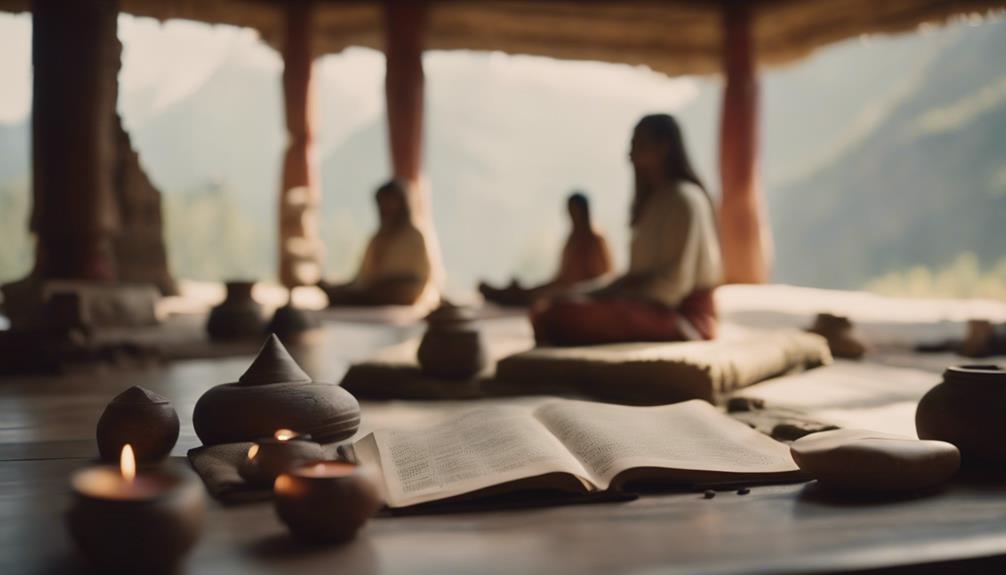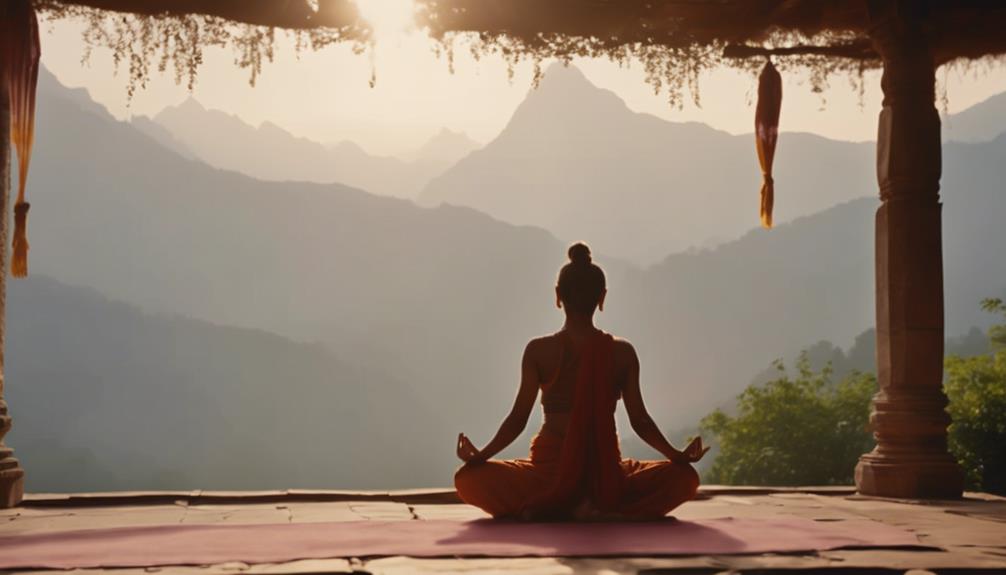What Is the Oldest Yoga Centre in the World?
The oldest Yoga centre in the world is found in India, it beautifully preserves ancient teachings and practices while complementing them with modern health and wellness approaches. This centre epitomizes the blend of traditional and contemporary, maintaining a deep reverence for the origins of Yoga. It meticulously preserves ancient techniques, emphasizes on the correct execution of asanas and nurtures the inner tranquillity through meditative practices. Considering its invaluable influence on modern-day yoga and lifestyle, you'll surely benefit from its depth of insight, if you choose to explore further.
Key Takeaways
- The oldest yoga center in the world is located in India, the birthplace of yoga.
- This historical center preserves ancient yoga teachings while offering contemporary programs.
- It seamlessly combines traditional elements with modern infrastructure for a unique yoga experience.
- The center upholds traditions like Aum chanting, Mudra practice, Pranayama, and Meditation.
- Through its influence on modern yoga, it emphasizes the holistic benefits of yoga for mind, body, and soul.
Origins of Yoga: Preclassical Period

Diving into the origins of yoga, you'll find yourself transported back to the Preclassical period, a time when this ancient practice was just beginning to take shape. It's during this era, the seeds of what we now know as yoga were being sown. The Preclassical Philosophy was instrumental in the development of yoga, representing a shift from ritualistic practices to a more individualized, experiential approach.
Yoga Scriptures, such as the Upanishads and the Bhagavad Gita, became the guiding lights of this evolution. These texts reveal intricate philosophies and practices, including meditation and ethical disciplines, that were designed to help individuals achieve a state of liberation, or 'moksha'.
Innovatively, this period saw yoga morph from a set of rigid rituals into a more holistic, personal experience. The emphasis was on internal realization rather than external ritual, marking a significant shift in thinking.
In essence, the Preclassical period laid the groundwork for the yoga that we practice today. It's a tribute to the adaptability and timelessness of yoga, that it has retained its core principles while evolving to meet the needs of each generation. This constant evolution gives yoga its enduring appeal and relevance.
The Birthplace of Yoga: India
While the Preclassical period laid the foundation for yoga, it's in India where this practice truly blossomed and took form. Indian philosophy heavily influenced this growth. The ancient scriptures of the Vedas and Upanishads serve as the bedrock of yoga's philosophical underpinnings. They introduced concepts such as Dharma (duty), Karma (action and consequence), and Moksha (liberation), which are integral to yoga's spiritual significance.
Yoga's evolution in India wasn't a linear process. It was a dynamic interplay of diverse philosophies, practices, and traditions that spanned centuries. It's in India that yoga morphed from a set of ritualistic practices into a detailed system of physical postures (asanas), breathing exercises (pranayama), and meditation techniques designed to foster physical health, mental clarity, and spiritual growth.
You must understand this history to appreciate yoga's depth and complexity. It's more than a physical exercise or stress-relief technique; it's a profound spiritual discipline rooted in Indian philosophy. Its spiritual significance extends beyond the mat, influencing every aspect of a practitioner's life. This transformative power is what makes yoga a vibrant, ever-evolving practice that continues to captivate people worldwide.
The Worlds Oldest Yoga Centre

Often considered the birthplace of yoga, India is also home to the world's oldest yoga center. This ancient institution brims with rich insights into yoga's mythology and history, offering a unique window into the past. Yet, it's not just the age of this centre that's remarkable – it's the centre's infrastructure too.
This centre is an architectural tribute to India's history, blending traditional designs with innovative functions. Here's why it's truly special:
- Historical Significance: The centre is steeped in yoga's mythology, preserving ancient teachings for modern practitioners.
- Architectural Brilliance: The infrastructure is a fusion of antiquity and modernity, reflecting the evolution of yoga over centuries.
- Innovative Programs: The centre offers innovative programs, combining traditional yoga practices with contemporary wellness trends.
- Community Impact: It's not just a yoga centre, but a hub for community engagement, promoting health and wellness among locals and visitors alike.
In short, this yoga centre is more than a place for yoga – it's a living, breathing embodiment of yoga's past and its vision for the future. Its infrastructure is a tribute to the timelessness and adaptability of yoga.
Traditions and Practices Upheld
You'll find the ancient techniques preserved here are a proof to the enduring wisdom passed down through generations.
These timeless yoga rituals, upheld with utmost reverence, offer a direct link to the historical foundations of this practice.
It's not just about the poses, it's about the philosophy, discipline, and spiritual growth that these traditions foster.
Ancient Techniques Preserved
In this renowned Yoga centre, ancient practices have been meticulously preserved, enabling you to experience and master techniques dating back thousands of years. From meditative postures to the study of Yogic philosophy, every facet of traditional yoga is revered and upheld.
Here, you'll find:
- Ancient asanas, with a focus on their original intent and nuanced execution.
- Meditative practices, designed to guide you towards inner tranquility.
- A deep exploration of Yogic philosophy, offering a profound understanding of the mind-body connection.
- A supportive community that cherishes the age-old wisdom of yoga and its transformative power.
In this centre, you're not just learning yoga; you're immersing yourself in a tradition, a philosophy, and a way of life that has endured for millennia.
Timeless Yoga Rituals
Diving into the timeless rituals practiced at this Yoga centre, you'll uncover a treasure trove of traditions upheld since antiquity. The fusion of Yoga Symbolism and Yoga Philosophy in each practice provides a holistic experience that goes beyond physical fitness.
Incorporating yoga symbolism, this ancient school uses visual representations that inspire deep introspection. The centre also places considerable emphasis on yoga philosophy, offering immersive lectures that stimulate intellectual curiosity.
Here's a glimpse of the key rituals:
| Ritual | Yoga Symbolism | Yoga Philosophy |
|---|---|---|
| Aum chanting | Represents universal consciousness | Reinforces the unity of life |
| Mudra practice | Symbolizes different states of mind | Connects mind, body, and soul |
| Pranayama | Embodies life energy | Promotes balance and harmony |
| Meditation | Symbolizes stillness and clarity | Enhances self-awareness and tranquility |
Influence on Modern-Day Yoga

You might wonder how ancient practices from the world's oldest yoga centre have shaped the yoga as it's understood today.
As we look at the evolution of yoga techniques, you'll see the clear impact of these time-honored traditions.
It's fascinating to recognize the profound influence they continue to have on modern-day yoga.
Ancient Practices' Modern Impact
Innumerable ancient practices from the oldest yoga centre in the world have greatly influenced modern-day yoga, contributing to its evolution and worldwide popularity. These practices, rich in meditation benefits and yoga aesthetics, have shaped the way people comprehend and practice yoga today.
Here's how:
- Meditation Benefits: Ancient yogic meditation techniques have been scientifically validated to improve mental health, paving the way for yoga's integration into modern wellness routines.
- Yoga Aesthetics: The aesthetic principles of ancient yoga have influenced the design of modern yoga studios, promoting an atmosphere of peace and serenity.
- Holistic Approach: The ancient understanding of yoga as a holistic practice is now a key part of its modern appeal.
- Philosophical Teachings: The philosophical teachings of ancient yoga continue to provide depth, transforming modern yoga from a mere physical exercise to a lifestyle.
Evolution of Yoga Techniques
The evolution of yoga techniques from the world's oldest yoga centre has had a profound influence on the way modern-day yoga is practiced and perceived. With the emphasis primarily on Yoga's health benefits, the ancient religious aspect has been adapted to a more contemporary approach.
Here's a quick look at the evolution:
| Ancient Technique | Modern Adaptation | Purpose |
|---|---|---|
| Meditative Postures | Dynamic Poses | Physical Fitness |
| Mantra Chanting | Breathing Exercises | Stress Management |
| Spiritual Enlightenment | Mindfulness | Mental Health |
| Ritualistic Practice | Yoga in Religion | Spiritual Growth |
From meditative postures to dynamic poses, mantra chanting to breathing exercises, spiritual enlightenment to mindfulness, and ritualistic practice to Yoga in religion, you can see how the traditional techniques have evolved to cater to the modern needs. This transformation highlights yoga's enduring relevance and adaptability.
Visiting the Oldest Yoga Centre
Often, visitors find themselves deeply immersed in the serene ambiance of the world's oldest Yoga Centre, engaging in age-old practices that promise a rejuvenating experience. The Centre's architecture, steeped in history, is a proof of the timeless nature of yoga, blending traditional design with elements that cater to modern yoga tourism needs.
When visiting, you'll be struck by the harmonious balance between the ancient and the innovative. Here are four key aspects you shouldn't miss:
- The Architectural Design: The Centre's architecture is an elegant mix of tradition and modernity, fostering a sense of serene tranquility.
- Yoga Sessions: Participate in yoga sessions that trace back to ancient practices, offering a unique experience of authenticity.
- Cultural Immersion: Engage in local traditions and customs that are intertwined with yoga, deepening your understanding and appreciation.
- Innovative Practices: Witness the innovative ways the Centre has adapted age-old yoga techniques to fit contemporary lifestyles.



